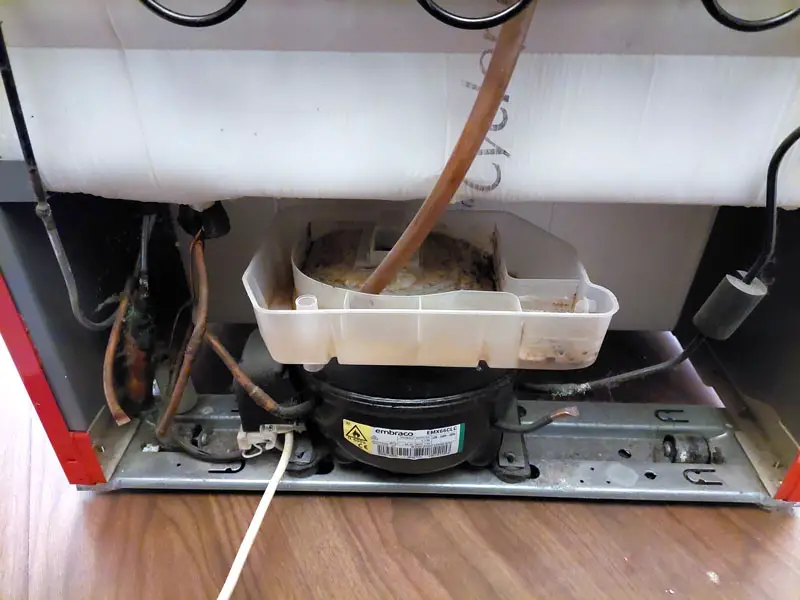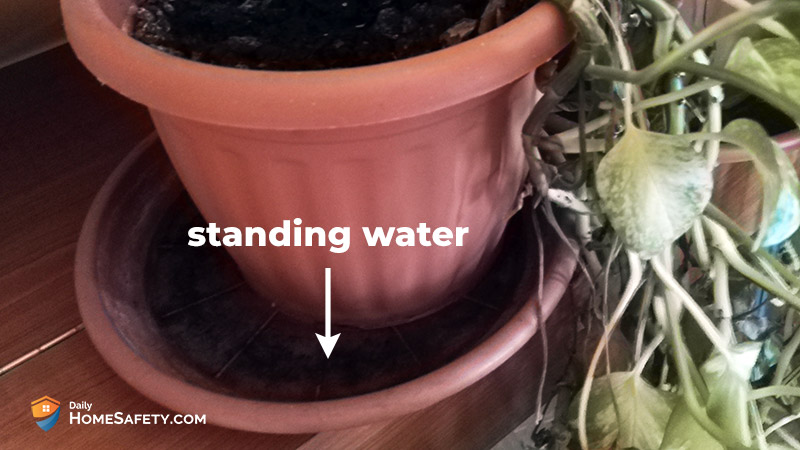So you’ve tried everything but can’t get rid of drain flies.
If you’re tired of the constant fight to eliminate those annoying little pests, you’re not alone. I’ve been there, so I know exactly how frustrating that situation can be.
Getting rid of all drain flies and preventing them from coming back often can be tricky.
Should you mess up one key element of the extermination process, you have to start all over again a few days later.
You are here because you want to say goodbye to your uninvited guests for good.
Let’s see what you need to do.
Know the Enemy: Facts You Must Know to Prevent Drain Flies From Coming Back
You can’t successfully exterminate these annoying insects until you understand what kind of environment they thrive in, what they eat, and how they reproduce.
Here’s what you need to know:
- Drain flies go through four stages (life cycle): egg, larval, pupal, and adult.
- One female drain fly lays up to 150 eggs. Those hatch into larvae. Adult flies will develop within 2-3 weeks.
- Drain flies need humidity (usually some form of standing water) to stay alive and reproduce. Larvae also need organic material, such as slime buildup in drain pipes.
- Besides adult drain flies, you must find all eggs and larvae in order to prevent them from reappearing.
- Therefore, you need to have one strategy for exterminating flies, and one for eliminating all eggs and larvae.
- Drain flies are often called sewer flies, filth flies, or moth flies but they’re all the same pests. So don’t be confused.
Now let’s see the reasons why drain flies keep showing up in your home.
1. Poorly Executed or Ignored Mechanical Cleaning

Many homeowners think that pouring some bleach and hot water down the drain will resolve the problem. They couldn’t be further from the truth.
Important
Imperfect mechanical cleaning is the number one reason why drain flies keep showing up over and over again.
Eggs and larvae are highly resistant to heat and chemicals, including harsh ones, such as bleach (source).
Also, the buildup of slime in the drainpipe often protects eggs from being destroyed by chemical treatment.
Thorough mechanical cleaning is important for two main reasons:
- it prepares the terrain for (bio)chemical cleaning
- it deprives the drain fly larvae of food by removing organic matter
By eliminating organic material and sludge, pipes and drains stop being ideal breeding sites for the upcoming generations.
I recommend you use a wire brush to clean your drains (sometimes you will need a drain snake too). Make sure you remove all built-up dirt and debris.
2. You Haven’t Found All Breeding Sites (and Newborn Flies Keep Appearing)
Drain flies can come from many different places, so often it’s hard to find all breeding sites, especially if there’s an extensive infestation.
It’s important to understand that you must destroy all eggs, larvae, and adult moth flies in order to prevent them from coming back after a few days or weeks.
What to Do If Drain Flies Are Not Coming From Drains?
It’s not uncommon that drain flies are not coming from a drain but from other places where humidity, stagnant water, and organic substances are constantly present. This includes, for example, toilet bowls, trash cans, septic tanks, rain barrels, and also HVAC systems.
You must check and clean all these places to get rid of drain gnats for good.
Here are the most common places where drain flies can come from:
- bathroom and sink drains
- floor drains
- sink overflows
- sump pump pit
- potted plants
- unused toilet tank
- condensation pans
- garbage disposal
- septic tank
- refrigerator drip pan
- areas under loose tiles
- leaky shower pan

Pro Tip: Check out this article where I explain how you can find all breeding places using some awesome (and simple!) methods.
Once you’ve found the place where sewer flies are coming from, you must clean it thoroughly. This must include both mechanical and chemical cleaning.
Remove all organic debris and slime with a stiff brush. When you’re done with the mechanical cleaning, move on to chemical cleaning. You can use baking soda and vinegar, Drano (when applicable), or an enzyme drain cleaner. Also, make sure you leave no stagnant water in the area.
3. Surviving Eggs or Larvae
Even if you’ve done a thorough mechanical cleaning, you still have to use the right and potent chemicals to completely remove the remaining organic matter, eggs, and larvae, otherwise, flies will return.
Most Powerful Products
In my experience, you get the best result if you use an enzyme drain cleaner, such as Invade BioDrain. It completely removes all organic debris and it’s way more effective than bleach, gel drain cleaners, dish soap, or other ordinary chemical cleaners. The best of all is that it doesn’t contain any harsh chemicals but only a special mix of natural microbes and citrus oil.
If the drain fly infestation is severe, you can also try an insect growth regulator (IGR), such as Gentrol Aerosol. What it does is prevent eggs and larvae from stepping into the next life cycle, so adult flies will never develop.
IGRs are highly effective, however, I suggest that you start with an enzyme drain cleaner because in most cases that will do a pretty good job and resolve the problem completely.
DIY Homemade Solution
If you prefer a completely natural method, you can try the combination of baking soda and white vinegar (or apple cider vinegar), but I must tell you that it often does a poor job.
You can increase efficiency by repeating the process 2-3 times and flushing the drainpipe with almost boiling water afterward (first make sure the pipe withstands such a high temperature).
FYI – If you want to get rid of drain flies as soon as possible, make sure you also check out this helpful guide where you will find every little trick you need to know to be successful.
4. You Ignored Prevention and Gave Flies a Chance to Return
You can’t sit back after cleaning each and every site where moth flies could lay their eggs. If you let things go on their own, chances are good that after a few weeks, flies will come back.
Prevention is essential when it comes to keeping drain flies permanently away from your property.
If you want to avoid reinfestation, you must be sure that drain flies won’t find an ideal environment in and around your house.
That being said, standing water shouldn’t be continuously present in your home. Wet areas should be cleaned thoroughly and regularly to prevent sludge from building up.

Also, make sure there are no leaky pipes or other sources of water that are continuously available for flies and their offspring.
After you’re done with exterminating, it’s highly recommended that you pay special attention to prevention for at least a month. During that period, there’s a much higher chance that sewer flies will come back if they find ideal breeding places.
5. Adult Drain Flies Keep Getting Inside From Outside
Removing drain flies from your home is one thing. However, in the first place, these small flies come from the outside.
Thus, if a female fly can get into your home (through windows, cracks, etc.) and find a suitable place for laying eggs, you can start the extermination process from scratch.
To prevent that situation, I recommend that you check those places around your house that can serve as a great habitat for flies. Think of septic tanks, rain barrels, HVAC condensation line drains, birdbaths, etc.
The fewer flies there are around your house, the lower the chance that one gets inside.
Also, if you see one on the wall, just smash it. Don’t let it sit there until it lays a ton of eggs on the wall of one of your pipes. Trust me, acting fast is key. If you are not thorough, they will keep coming back.
+ 1: Make Sure You Don’t Confuse Drain Flies with Other Flying Insects
Sometimes the only cause of failure is that you’re trying to get rid of a pest that’s not even present in your home.
A drain fly is a tiny creature and can easily be confused with another similar insect, such as a fruit fly, fungus gnat, or even a housefly.
The extermination process can be completely different in the case of another species, so correct identification is key to success. When in doubt, you can always take a photo of the fly and ask a professional exterminator or a pest control company.
Summary
The most common reason why drain flies keep coming back to your home is improper mechanical cleaning that allows eggs to turn into adult flies. Also, failing to eliminate all breeding sites and using ineffective chemicals will result in the drain flies returning over time.
Therefore, it’s very important that you check and remove each and every possible breeding ground and use effective chemical and mechanical cleaners to destroy any organic buildup inside pipes.
FAQ
Can Drano help you get rid of drain flies?
Drano will definitely help you eliminate drain flies from your home. Drano kills larvae and removes clogs and organic buildup on the wall of the drain pipe which is the number one place where drain flies lay their eggs. For a permanent solution, however, often you’ll also need thorough mechanical cleaning.
Can drain flies come from the toilet?
If you neglect cleaning the toilet, drain gnats can use the buildup of organic debris inside the bowl to lay their eggs. Sometimes flies are coming from the tank. This scenario is more common when a toilet is unused for a few weeks.
How to kill drain fly larvae?
The best way to kill all larvae is to prevent them from stepping into the adult life cycle using an insect growth regulator. Enzyme drain cleaners are also effective as they destroy their habitat and deprive them of food. You can also try a gel drain cleaner, such as Drano.












